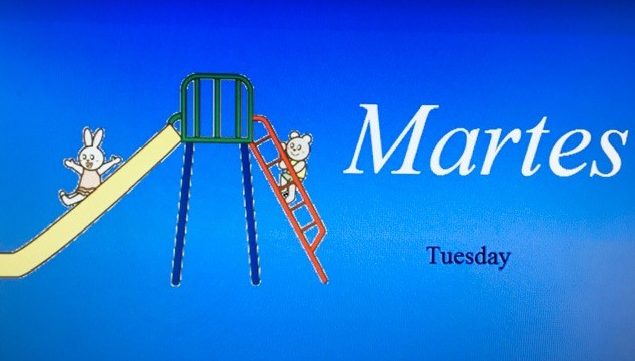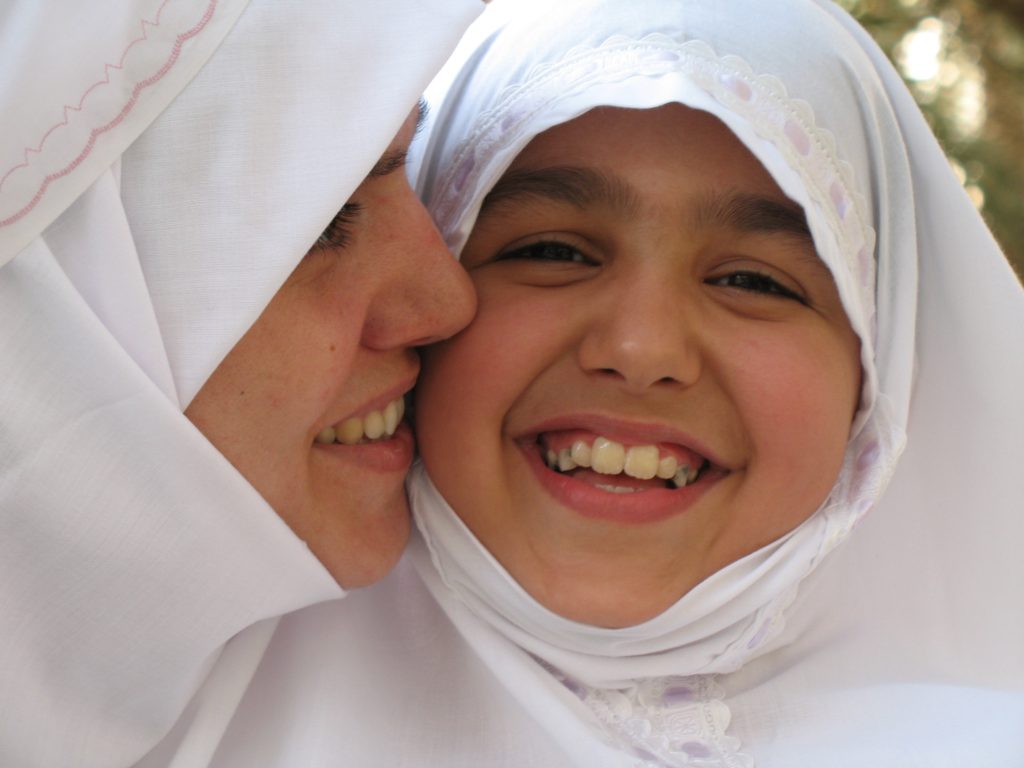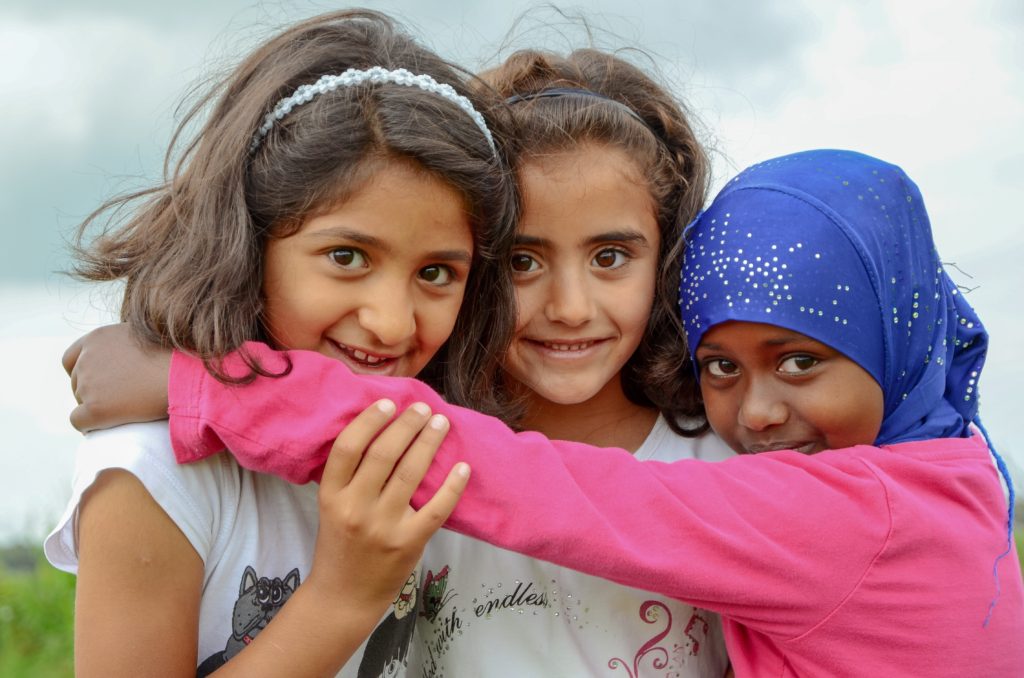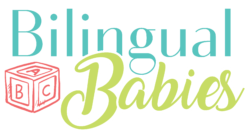Kylie Peslak is a preschool teacher in the United States with a BA in Early Childhood Education. She is monolingual herself, but has several bilingual children in her classroom each year. In this interview, Kylie shared how she promotes the children’s languages on a daily basis, what activities and projects she does each year, the challenges she has encountered, and how she includes parents and the larger community to help boost the children’s multilingual identities.
Veronika:
Can you tell me a little about your background? You’re a preschool teacher?
Kylie:
Yes. I’ve been teaching preschool for seven years. I have 13 years of experience working with children. My experiences working with children began in high school. I have experience working as a preschool teacher, camp counselor, a tutor, substitute teacher, nanny and classroom aide. I have always been passionate about working with young children. I’ve been here at the YMCA Early Education Center for seven years teaching preschool children.
Veronika:
The YMCA Early Education Center is not a bilingual daycare program, but you do have a lot of Spanish influence here at the daycare and other languages as well, right?
Multiple languages in one classroom
Kylie:
 Yes. There’s a large Paraguayan community in Bernardsville and we do get a lot of Spanish- speaking students at school. Each year, I typically have three or four students whose native language is Spanish. Some of them come to me speaking English fluently, while some of them are just learning the English language. In the past, I also had a number of Mandarin-speaking children. Right now, I have four bilingual children, including Ella. Three of them speak Spanish at home, then Ella speaks German at home. I also have another student who is learning how to say some words in Tagalog.
Yes. There’s a large Paraguayan community in Bernardsville and we do get a lot of Spanish- speaking students at school. Each year, I typically have three or four students whose native language is Spanish. Some of them come to me speaking English fluently, while some of them are just learning the English language. In the past, I also had a number of Mandarin-speaking children. Right now, I have four bilingual children, including Ella. Three of them speak Spanish at home, then Ella speaks German at home. I also have another student who is learning how to say some words in Tagalog.
Veronika:
How do you deal with this cultural and linguistic variety?
Building relationships with parents
Kylie:
I think the main goal is building relationships with the parents and the children. COVID has certainly changed things a little bit, but what I usually have done in the past, was this: on back to school night, I would bring all of the parents together and encourage them to be part of our classroom community. I like to tell the parents that this is not my classroom, it’s our classroom, and whatever they want to bring to the table, I’m happy to incorporate. We discuss the different holidays they celebrate, their culture, as well as the different languages that are spoken at home. For instance, you started the St. Martin’s Day Parade. I like to invite the parents to come in to help us celebrate different holidays that are important in their family. Every holiday is a special one in our class.
 In my first year, here at the Y, I had several children with an Asian background that spoke Mandarin at home. That year, our Chinese New Year celebration was incredible! We had parents come into the classroom with food, projects, and a few parents even read books in Mandarin. It was a huge celebration. So, I think it’s really about building those relationships with the parents and taking the time to learn about each family. I think it’s important to make the children and their families feel important and welcome, so that the children feel comfortable speaking their native language in the classroom. It’s all about making the classroom a safe and enjoyable environment so they feel that it’s okay to be themselves.
In my first year, here at the Y, I had several children with an Asian background that spoke Mandarin at home. That year, our Chinese New Year celebration was incredible! We had parents come into the classroom with food, projects, and a few parents even read books in Mandarin. It was a huge celebration. So, I think it’s really about building those relationships with the parents and taking the time to learn about each family. I think it’s important to make the children and their families feel important and welcome, so that the children feel comfortable speaking their native language in the classroom. It’s all about making the classroom a safe and enjoyable environment so they feel that it’s okay to be themselves.
So, as far as the parents, it’s also important to connect them with one another too. That first group that I had, most of those families are still in contact with each other. They’re one big family now.
Monolingual teacher + multilingual children = no problem
That’s really cool. Other than involving parents and holidays, how do you incorporate the children’s different native languages in the classroom on a daily basis since you don’t speak all of these languages?
Kylie:
Oh no, I don’t! I am monolingual. Born and raised in New Jersey, have lived here my whole life. Both of my parents speak English. My mom is Italian and German, my dad is Polish, Irish, and French. But even their parents, I only met three of them, but all of them spoke English. They came to the U.S. in the late 1800s, early 1900s.
Veronika:
Okay, so they came here a long time ago. How do you make it work without speaking all of your children’s languages?
Including different languages at circle time & during stretching
Kylie:
We usually start the day with circle time. Each week our class picks a different language card and we learn how to say hello in another language. We take turns going around the circle greeting one another. For the greeting, the children say their friend’s name, like, “nǐ hǎo, Veronika”, then you’d say, “nǐ hǎo, Kylie”. It’s only one word, but it usually sticks. We usually look for the country on the map and learn a few fun facts about where that language is spoken. It’s important for them to learn about other cultures and languages.
Casually throughout the day, we throw in words in different languages. For example, Ella has shown us how to count in German. We have another student who has been teaching us Tagalog, which is spoken at Philippines. None of the children speak Mandarin at home but since I know how to count in Mandarin, we’ve been practicing that too. We have some children who speak Spanish, so we often count in Spanish. Besides counting, we also practice common words and phrases like “please”, “thank you” and “bathroom”. Oh, here’s a nice example: Our class was outside exercising and stretching a few weeks ago. First, we counted in Spanish, then we counted in Tagalog, and then a woman walked by and she said, “You guys are great.” And I thought “yeah, aren’t they?” And she continues, “But I bet you can’t count in German!” So I told her “Oh my gosh, they can, these kids are amazing!” She was so impressed. It’s moments like that when the kids are getting such a boost in confidence!
We use other languages whenever the children bring them up. Today, for instance, we were standing in line waiting to wash hands and I can’t remember the exact phrase, but Ella said three words in German. I asked her what she said, and she told me that she was saying “I need to wait”. After that, Ella’s friends started repeating the phrase. During lunch time, a lot of the children will ask each other how to say different food items in another language.
 Playing music in another language is also a very simple thing that can also be done in class. I typically like to play music during seat work and when the children are arriving in the morning. Before you know it, the children will be singing along, and it requires very little effort from the teacher! One of our favorite songs is “The Days of the Week” in Spanish.
Playing music in another language is also a very simple thing that can also be done in class. I typically like to play music during seat work and when the children are arriving in the morning. Before you know it, the children will be singing along, and it requires very little effort from the teacher! One of our favorite songs is “The Days of the Week” in Spanish.
Diversity in literature is also very important. I like to expose my students to a wide variety of children’s books to give students an opportunity to develop insights about others.
The smallest moments can have the biggest impact
So, if you come into our classroom, you’ll hear random words in different languages all day long. We just throw words in all day, and a lot of it is initiated by the children. I believe that it is important as a teacher to support that, because these small instances signal to the children that it’s okay to use their languages. There are different ways of saying things, and this is the perfect opportunity for the children to be exposed to other languages.
Veronika:
You are basically running a language awareness program.
Kylie:
Yes. I also think it helps a lot with identity. Ella, for instance, seems proud of her German identity. I actually wrote that on her evaluation this year. She’s is very proud and she makes it known to all of her friends and teachers.
As a mom, that is nice to hear. It is also very helpful because it if they are proud of their languages, they have a positive relationship to it and that supports all of their languages. If they are only allowed to use one, they may feel like half of them is not being valued.
Kylie:
That’s the most special thing. I wish you could see her face sometimes when she hears someone speaking German, and not just her, but the other children in class who are bilingual. So, for Ella to hear me say, I don’t know, shoes, or Schuhe. Just little things, she’ll just smile. Sometimes I’ll say something in German, or play a song in German, and it puts a smile on her face. Who knows if I’m saying the words correctly but she knows that, ‘wow, my language is important’. German is important. And it makes them feel special.
Veronika:
It does.
Make children and parents feel that their languages are accepted and valued
Kylie:
A lot of parents, especially of the Spanish speaking children in my class, don’t want their children to speak their native language at school. I try to encourage it, but many times the children are hesitant. Ella is the only one that speaks German but there are a few children who speak Spanish. But generally, their parents discourage it at school. I have heard parents tell their children that Spanish is for home and this is school, so they should stick to English. But when your friends can learn from you, and your teachers can learn from you and you can learn from each other, it’s so valuable. So, I encourage them to speak to their friends in whatever way makes them comfortable. A couple of them do, and couple of them are a little hesitant. How do you feel about that?
Veronika:
I think every child should be encouraged to use all of her languages. So, yes, encouraging it again and again is a really great way of going about it. Especially with minority languages that may not have the same recognition or esteem in society, it can make a difference. You know, here in the U.S. there seems to be a difference between being raised with Spanish versus learning Spanish later on in school. It seems that if you choose to learn Spanish, “wow, you’re awesome, you speak Spanish, you chose to learn that”. But if it’s your heritage language, it’s oftentimes looked down upon. That is a pity!
Kylie:
It’s a shame that it’s like that.
Children should be proud of all of their languages
Veronika:
 It’s almost the same situation in Germany with languages like Turkish or Polish. For some cultural or historical reasons, there are some languages that are valued less than others. It is a shame! And the worst thing is that kids are picking up on these things by observing how adults’ act toward the languages. In an educational setting, you may even lose the kids because you’re not recognizing all of who they are.
It’s almost the same situation in Germany with languages like Turkish or Polish. For some cultural or historical reasons, there are some languages that are valued less than others. It is a shame! And the worst thing is that kids are picking up on these things by observing how adults’ act toward the languages. In an educational setting, you may even lose the kids because you’re not recognizing all of who they are.
Kylie:
Right. It makes them feel like they’re not important. Like, oh, this is something that’s only done at home. Why can’t I speak this language at school?
Veronika:
Right. I sometimes do professional development (PD) trainings at local libraries. At one training, there was a Spanish-speaking mom. We were talking about what language(s) to use when you drop off your child at daycare or at school when everyone around you just speaks English. I struggled with that too in the beginning. That mom at the PD training made a great point that has become my credo too. She said “I want my child to see me use Spanish because I’m not ashamed of it. I don’t need to hide it.” I thought that’s a really good point.
Kylie:
It is! And I’ve observed your drop off too.
As a parent, we are role models
Veronika:
It’s tricky. Nobody understands German. So when I speak German only, I’m excluding people which is rude. Plus, in my heart, I’m all about building bridges and including everyone. But then I also want Ella and Alex to get as much exposure to German as possible and, yes, I also want to show them that they can be proud of their German heritage. So what I try to do is this: I say the German first, so the kids need to process the minority language first and then I repeat it in English. That’s what I do over dinner every night to get German in but not exclude my husband who doesn’t speak German.
Kylie:
I like when you do that because sometimes, even though I don’t understand what you’re saying, I get a pretty good idea of the message that you are communicating to your child. But now that I’m thinking about it, we have some parents that will only speak English to their child in front of me during pickup and drop off.
Veronika:
But they are native speakers of Spanish?
Kylie:
Yes. What do you think about that when a parent doesn’t speak his or her native language with the child?
What language you use as a parent can have an impact on the relationship with your child
Veronika:
 It depends a lot on how proficient and comfortable you are using the second language. Overall, if they are not 100% comfortable with using English, for example, but they only speak English to their children instead of Spanish, that can have several repercussions. For instance, it can communicate to the children that Spanish is worth less than English. Also, when you as a parent try to speak to your child in a language that is not the language of your heart, it may impact the emotional ties. In other words, the relationship with your child is impacted. As parents, when we interact with our children, we sometimes burst into a song or we make a joke in the spur of the moment. But when we as a parents struggle with the language ourselves, these things become difficult. We may not have the language or cultural knowledge we need in order to fully engage with our child. For example, you may not know English nursery rhymes or songs, so as a parent you don’t just start singing in the spur of the moment. You may even struggle with disciplining your child. And you may even struggle to tell your child how much you love her. It’s these small or every day moments where the language you use makes a difference.
It depends a lot on how proficient and comfortable you are using the second language. Overall, if they are not 100% comfortable with using English, for example, but they only speak English to their children instead of Spanish, that can have several repercussions. For instance, it can communicate to the children that Spanish is worth less than English. Also, when you as a parent try to speak to your child in a language that is not the language of your heart, it may impact the emotional ties. In other words, the relationship with your child is impacted. As parents, when we interact with our children, we sometimes burst into a song or we make a joke in the spur of the moment. But when we as a parents struggle with the language ourselves, these things become difficult. We may not have the language or cultural knowledge we need in order to fully engage with our child. For example, you may not know English nursery rhymes or songs, so as a parent you don’t just start singing in the spur of the moment. You may even struggle with disciplining your child. And you may even struggle to tell your child how much you love her. It’s these small or every day moments where the language you use makes a difference.
Kylie:
It’s very interesting that you’re saying this, because I recently spoke with a parent about her child’s behavior at home. The mother’s native language is Spanish, her children are bilingual, and she’s struggling with discipline at home. I wonder if she’s speaking English at home. If so, I could see where there could be some discipline struggles if she is not confident speaking English.
Veronika:
That could be it. We do build our own identity and also authority as parents through language.
Making sure each child knows: ‘Hey, all your languages are welcome!’
Kylie:
It is important to encourage to use Spanish or the language you are comfortable with. I think from a teacher’s perspective, that’s the main goal to signal, ‘hey, your language is welcome’.
Veronika:
Right, it’s important. And from a bilingual parent’s perspective: it’s important to us as parents too. It sometimes breaks the ice with parents.
Kylie:
It definitely does.
Veronika:
It’s also important to keep in mind that some parents or families may have experienced so much negativity towards their cultural heritage and their native language that it’s sometimes tough to flip the switch and hold up your heritage because you want your children to succeed.
Kylie:
Totally! Especially now with COVID, we don’t really get that face-to-face, quality time with the parents. You remember how it was, every day you’d see us in the morning and in the afternoon. Now, it’s like I see you, but there’s eight kids with me. This interview is the most I’ve talked to a parent in probably a year.
Veronika:
I can imagine.
Kylie:
And it’s sad, things have changed. Even those little connections. I feel like they do make a world of difference.
Veronika:
Yeah, they do. It’s really the key to foster diversity and include the families and their cultures.
Implementing a virtual summer travel program for kids
Kylie:
 In the summer, my students can either stay in my class or go to camp, most of them are staying here. As I told you earlier, we incorporate little things in our everyday routine to recognize different cultures and languages. One of my bigger projects that I do is over the summer. Over the course of seven weeks, my students will “visit” the 7 different continents. The children travel around the world learning about many different cultures. They get a passport with their picture, they go through security, they get on the airplane, and we spend one week on each continent, visiting different countries. I send home an invitation in the beginning of the summer inviting the parents to contribute to our summer travel program. In the past, parents have brought in food, traditional clothing, taught us dances, put on musical performances, read books, and much more! Hopefully, this year, we can have parents come in, but we can also have them attend via zoom. So, Europe, Veronika, what can you offer here?
In the summer, my students can either stay in my class or go to camp, most of them are staying here. As I told you earlier, we incorporate little things in our everyday routine to recognize different cultures and languages. One of my bigger projects that I do is over the summer. Over the course of seven weeks, my students will “visit” the 7 different continents. The children travel around the world learning about many different cultures. They get a passport with their picture, they go through security, they get on the airplane, and we spend one week on each continent, visiting different countries. I send home an invitation in the beginning of the summer inviting the parents to contribute to our summer travel program. In the past, parents have brought in food, traditional clothing, taught us dances, put on musical performances, read books, and much more! Hopefully, this year, we can have parents come in, but we can also have them attend via zoom. So, Europe, Veronika, what can you offer here?
Veronika:
I guess I’ll put some thought into that!
Kylie:
 It’s been a huge thing in our class that families look forward to. We learn about the art, literature, music, food, animals, and languages of many different countries. The children get a very valuable experience and they learn a lot about their friends and their teachers. We have even had some of the directors from other departments participate as well. So, that’s one thing that I do every summer that’s a lot of fun. It’s a great opportunity for the parents to come in to teach us about their culture. One year, I had a few grandparents come in. Another year, we had a family member send something from Poland, and other year a sibling came in and performed a traditional Paraguayan dance. It’s the kids’ final big project before they head off to kindergarten.
It’s been a huge thing in our class that families look forward to. We learn about the art, literature, music, food, animals, and languages of many different countries. The children get a very valuable experience and they learn a lot about their friends and their teachers. We have even had some of the directors from other departments participate as well. So, that’s one thing that I do every summer that’s a lot of fun. It’s a great opportunity for the parents to come in to teach us about their culture. One year, I had a few grandparents come in. Another year, we had a family member send something from Poland, and other year a sibling came in and performed a traditional Paraguayan dance. It’s the kids’ final big project before they head off to kindergarten.
Veronika:
That is great!
I have another question for you: have you encountered any challenges with children speaking multiple language, like when they interact with each other or if you have had any obstacles to overcome?
Children with lower English skills are more hesitant during group work
Kylie:
Yes, definitely. Every child is different, and I usually have the opportunity to observe the children from when they’re in the Toddler class or in Preschool 1. I see them in the gym or in other shared spaces, and it’s nice because I can observe their progress over the years. What I’ve found is that the children who come to the Preschool 1 class not speaking English yet, they make some progress but they’re a little less comfortable versus the children who have started speaking English earlier on. So, when they come to me and they have only spoken English for one year, I found that they’re more hesitant to join a group. They’re a little more reserved, a little hesitant sometimes to raise their hand or speak out, even though they have a really good understanding of what’s being said. One child in particular right now, he started learning English last year. I observed him in Preschool 1 and he has made a tremendous amount of progress. But he’s still a little hesitant and I don’t think it’s his personality, I think it’s the language. He’s just a little nervous sometimes to join a group or to speak up.
Veronika:
Yeah, understanding usually precedes speaking. Maybe his speaking is not there yet and he is lacking confidence.
Kylie:
 Yes, I think he doesn’t have the right level of confidence yet. Speaking one on one is okay, but when in a group, he’s a little hesitant to speak up. But the great thing about kids: they can literally become friends without speaking one another’s language. In the beginning of the year, two of the kids had the same shoes; instantly best friends. Like, “Oh, we have the same color shoes.” So, I’m like, alright, hold hands…still best friends. If only it were that easy when we grow up…
Yes, I think he doesn’t have the right level of confidence yet. Speaking one on one is okay, but when in a group, he’s a little hesitant to speak up. But the great thing about kids: they can literally become friends without speaking one another’s language. In the beginning of the year, two of the kids had the same shoes; instantly best friends. Like, “Oh, we have the same color shoes.” So, I’m like, alright, hold hands…still best friends. If only it were that easy when we grow up…
Veronika:
Yes, that would be great!
Kylie:
I had a student who came to me in my first year, so seven years ago, not speaking any English. He made friends immediately. It was very interesting. So, I think these children do not have too many issues forming friendships, it’s just joining a group that may be challenging. That’s what I’ve found. If there’s a group of kids, they seem a little more hesitant asking to play.
Veronika:
Yes, probably a matter of confidence.
If your coworker is not on the same page…
Kylie:
Also, I think it’s important to be on the same page as your coworkers. If you have an assistant, someone working with you, you both should follow the same game plan. That was a challenge for me at one point when I had a child in class who spoke Mandarin. It required a lot of patience and dedication. I was committed and wanted to do all that I could to help this child to succeed in the class. It was a little challenging because the other teacher was set in her ways. She said ‘this is how it is and how we do it’ and she kept rushing through things, while I was in the corner of the room trying to use Google Translate. I think working with such a co-worker is challenging when you’re trying to teach a child a language. The child has to set the pace.
Veronika:
Definitely.
Kylie:
So, for example, when I do an assessment, I’ll have the children complete it in their native language, as well as in English. And a lot of them will show understanding in their native language but not yet in English. So, basic concepts are there it is just a matter of wording them.
Veronika:
When you speak of assessment, what exactly do you do?
Best practice in assessing children’s literacy skills and abilities
In September, I sit with each child, and review basic skills based on the kindergarten readiness assessment that they’ll participate in prior to going to kindergarten. I’ll observe skills such as letter recognition, letter-sound correspondence, number recognition, counting, shapes, colors, etc..
Veronika:
How do you do that?
Kylie:
It depends, sometimes I’ll sit with a child and I’ll point at a letter and they will tell me what it is. For other kids, it’s a game. It’s like, alright, go find the letter G that’s written in chalk on the sidewalk. Or go find a B somewhere around the room. So, sometimes it’s more informal, just to kind of get an idea of where we’re at.
Veronika:
Do the kids know they’re being tested?
Kylie:
No, they have no idea. It’s not a test. Sometimes it’s just, ‘alright, we’re going to sit and look at these animal flashcards. It’s a game, but I’m observing and evaluating…And some parents want that information too. I found that some of the bilingual children, their parents want to know; can they identify their letters, can they identify their numbers? Because some parents will want to work with them at home. As an assessment expert, how do you feel about the observations that I do?
Veronika:
That’s exactly how you should do assessments at this age. It’s like best practice! You cannot do good teaching without assessing, it’s like two sides of a coin, but it needs to be done in a child-appropriate way. Turning it into a game, a fun interaction is key. Sounds like I could do a best practice case study on you. [both laugh]. No seriously, that is awesome.
Okay, last question: what advice would you give to other teachers to promote language awareness in the children or foster a multilingual environment?
Advice #1: Set a routine to give English learners more stability in the classroom
Kylie:
I think one of the most important things, especially for English language learners, is to follow a routine. For children who are learning English in the classroom, it’s easier for them to follow along if you stick to the same routine every day. I think it’s also important to not view a language diversity as a challenge, view it as an opportunity.
Veronika:
Yeah, that’s a good point. They know what’s coming. It provides guidance.
Advice #2: Look at the many languages in your classroom as a resource, not as a burden
Kylie:
I would challenge a fellow teacher to see how much they can learn from their students and their families. Don’t look at it as, “oh, they speak this at home and I have to incorporate it in class.” Look at it as, “what can I learn from these families and what can they bring to the classroom?” I think it helps to take on a positive perspective when dealing with many languages in a classroom. 
Advice #3: Use a lot of visuals
I think it’s also important to use lots of visuals in the classroom, especially for English language learners. In the beginning of the year, I have a visual schedule posted on the wall for the children. They don’t need to speak English to be able to understand what’s happening next in class. It gives them confidence to help get through their day. For students who are reading, teachers could post labels around the classroom (door, sink, desk, etc.) in multiple languages.
Advice #4: Keep open communication with parents
It’s important to keep open communication with the parents just so everyone is on the same page. For children like Ella who are fully bilingual, they typically don’t struggle in class with speaking the language. But there are children who do struggle a little bit, and I constantly have open communication with their parents to discuss how we can help their child succeed in class. I also like to introduce parents to each other to help build our school community.
As teacher I think it’s important to always be willing to learn and grow.
Veronika:
Thank you so much for your insights. I learned a lot from you today!







2 comments
Hi My name is Aminah Hussain, I am currently living in Turkey and working as an early years school teacher in a bilingual school- Turkish and english. I am currently in charge of working on the school curriculum but i am struggling with the method of how to teach both languages, for e.g. would i have both Turkish program for reading and english- as there is one native english speaker in the class and a Turkish teacher. I would love some advice from your experience.
Hi Aminah,
The answer to your question depends on a number of things: for instance, how many teachers do you have per classroom? What languages do they speak? That is, can you do one-teacher-one-language? Or is one teacher tasked with promoting both languages or even more if you strive for a multilingual approach (e.g., Awakening to Languages approach)? For starters, I can recommend two books to you: “Bilingual Preschools: Best practices” Volume 1 and 2. The volumes were edited by Kristin Kersten, Andreas Rohde, Christina Schelletter, and Anja K. Steinlen. If you google the title and the editors’ names you should find free pre-print versions of the books.
Best of luck!!